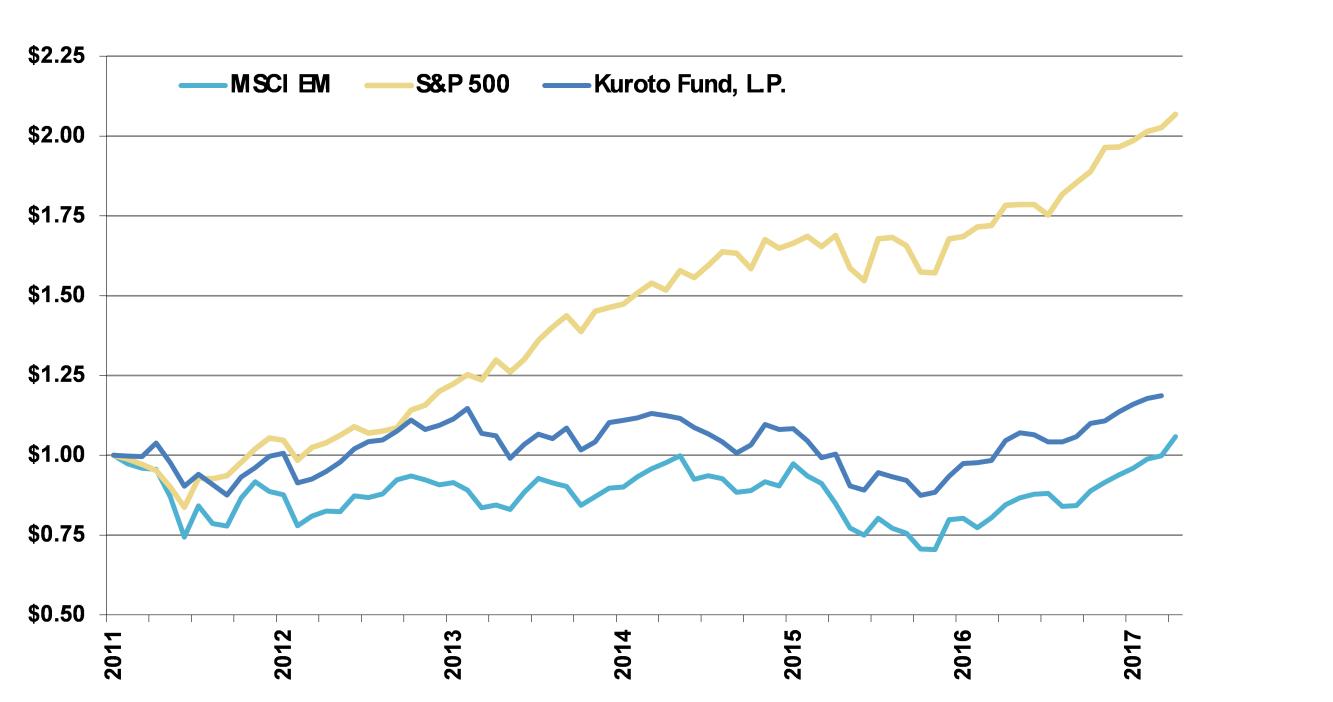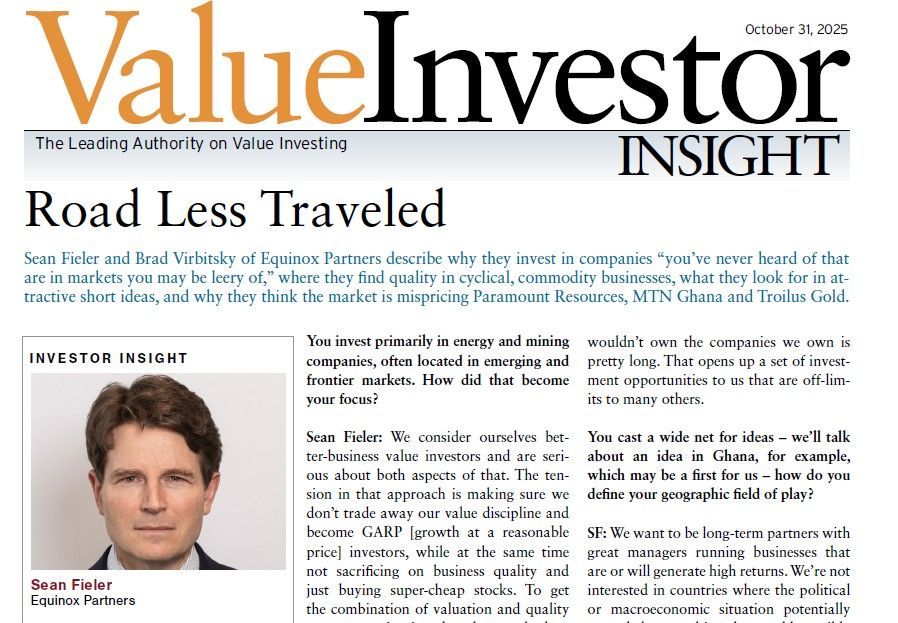Kuroto Fund, L.P. - Q2 2017 Letter
Dear Partners and Friends,
PERFORMANCE & PORTFOLIO
In the second quarter, Kuroto was up +4.5%. This compares with a +6.3% increase in the EM index over the same period. For the year to date through July 31, we estimate Kuroto appreciated +12.8% while the index gained +25.7%.
[1]
During the second quarter, we exited positions in a UK-based event manager and a Filipino consumer goods company due to full valuations. We also invested in a Kenyan consumer company and a Korean pharmaceutical company.
value investing as a discipline
Since the end of January 2016, the emerging market index has risen 50%. This compares with Kuroto’s 37% appreciation over the same period. We are neither happy nor surprised with our underperformance. Our strategy of long-term value investing is prone to underperformance when investors become less concerned about valuation. It is at moments like this that value investing becomes a discipline and not just a strategy. It is never easy to remain skeptical as others throw caution to the wind. That said, we believe our response to rising valuations will strike our investors as entirely predictable. Specifically, we have been gradually increasing our cash position as we find fewer new investments at attractive valuations.
Given the oft-noted relative undervaluation and underperformance of emerging markets in recent years, our caution may strike some as premature. To be clear, the relative value argument is true. Even after this rally, EM equities trade at a near 25% discount to their developed market peers. The EM index trades at 16x this year’s earnings while the S&P trades at 21x. It is also true that the emerging market index is essentially flat in dollar terms going back to its early 2011 peak.
That being said, as value investors, we do not find the relative-value rationale particularly compelling. Just look at the market against which emerging markets are being compared. The S&P 500 is in its eighth year of a bull market that on some measures rivals the equity blow off of the late 1990s. And, over the past year and a half, emerging markets have appreciated sharply as they too have benefited from the wall of liquidity sloshing around globally. The predictable result of this broad, liquidity-driven run up is that few countries, sectors, or themes in emerging markets remain cheap. Accordingly, rather than trade down on quality or up on valuation, we have become less invested.
Value investors worthy of the name are interested in absolute, not relative value. We ask, “is the business we are buying worth significantly more than what we are paying for it?” With most high-quality EM businesses trading at more than 20x earnings, the answer to this question has increasingly become no. Saying no so often can be frustrating, but even a cursory review of the past twenty years of emerging market investing reminds us of the importance of sticking with an absolute criteria.
After all, it was absolute, not relative analysis that allowed us to buy great businesses at large discounts in 1999 and late 2008, even when the consensus was certain that this was the wrong thing to do. It was, of course, difficult to act rationally when the stocks of our companies were going down every day. But, that is the other side of the value investing discipline. Moreover, we know that consistently adhering to absolute standards of valuation is the best way for us to outperform the market over time.
Not surprisingly, disciplined value investors will almost always miss the phase of a bull market in which stocks disconnect from their underlying intrinsic value. The recent phase of the emerging market rally is a case in point. Passive funds with large inflows have been indiscriminately buying and, not surprisingly, emerging markets are appreciating with remarkable uniformity: a tell-tale sign of a liquidity-driven and not a fundamentally-driven market. The only EM countries in the red this year are Russia, Qatar, and new entrant Pakistan.
To be clear, we are cautious, not bearish, on emerging markets. We remain 88% invested and are enthusiastic about the long-term prospects of our 26 undervalued, high-quality companies. On a look-through basis, our companies are trading at 14x this year’s stated earnings, and 8 of our 26 companies have significant investments or subsidiaries that aren’t captured in a standard PE ratio. Moreover, we expect our companies to generate mid-teens, long-term earnings growth on top of 20%+ adjusted ROEs.
We have already raised our cash balance to 12% of the fund’s capital. If EM stocks rise further in a uniform, liquidity-driven fashion, we will happily generate more dry powder. But, if the past twenty years of history is any guide, we will not have to wait too long for an opportunity to get more fully invested somewhere in the developing world.
Organization
Over the past year, we’ve made several changes to our team that merit comment. Beginning with the research team, we hired Amy Sheng and Nick Engel as Kevin Gallagher and Andrew Koger moved on to the next phase of their careers. Amy Sheng, a Yale graduate in math and philosophy and native of China, joined our firm last year following her internship with us the prior summer. Nick Engel joined us full-time in January following his internship with us last fall and the completion of his doctorate in philosophy from Columbia. We wish our departing analysts, Kevin and Andrew, the best in their new endeavors. Kevin is pursuing an MBA at Columbia, and Andrew has taken a job with Alibaba’s Southeast Asia e-commerce platform in the Philippines. We also upgraded our operational staff when Stephanie Tran joined us last August. With a degree from Holy Family University and impressive experience at several small businesses, Stephanie has our office running more smoothly than ever. The entire team is now thirteen: seven in operations and six in investments.
Sincerely,
Sean Fieler
Daniel Gittes
END NOTES
[1] Performance stated for Kuroto Fund, L.P. Class A on a net basis. An investor’s performance may differ based on timing of contributions, withdrawals, share class, and participation in new issues. Unless otherwise noted, all company-specific data derived from internal analysis, company presentations, or Bloomberg. Company valuations and exposures expressed as of 6.30.17.










